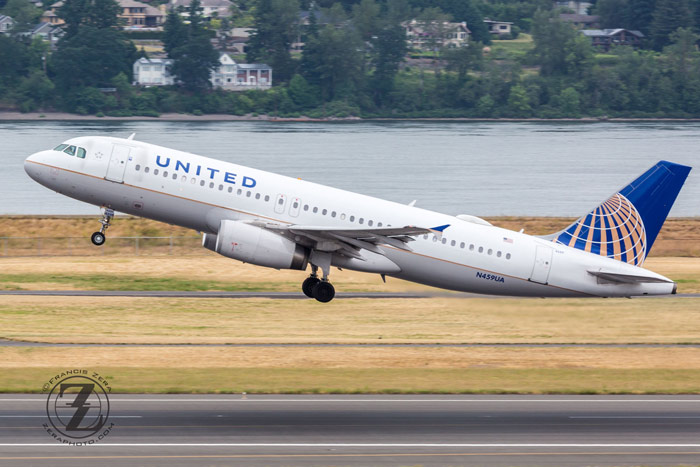
Tired of boardling last while flying coach? United has your cure, for nine bucks.
Note: This story was written earlier in March, but we opted to hold off a bit before publishing it so we wouldn’t look like insensitive clods in light of United’s recent, um, customer service issues. They seem to be coming around and hopefully this will make things even better Eds.
As of March 2, 2018, passengers flying in anything other than basic economy with United Airlines can purchase “early boarding” for nine non-refundable bucks, a la American Airlines. The fee allows travelers to line up when the gate agent calls for boarding group two.
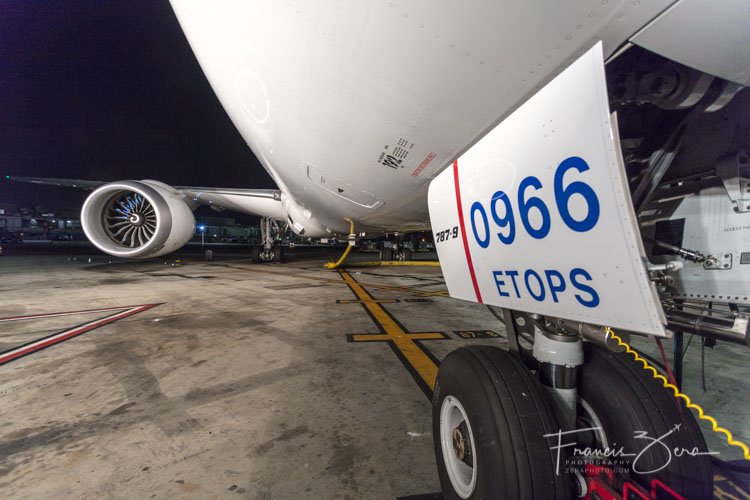
Our United 787-9 being made ready for the inaugural long-haul LAX-SIN flight
Superlatives abounded on this, the inaugural non-stop flight from Los Angeles to Singapore. It’s billed as the third-longest direct flight in the world and the longest to originate from the United States.
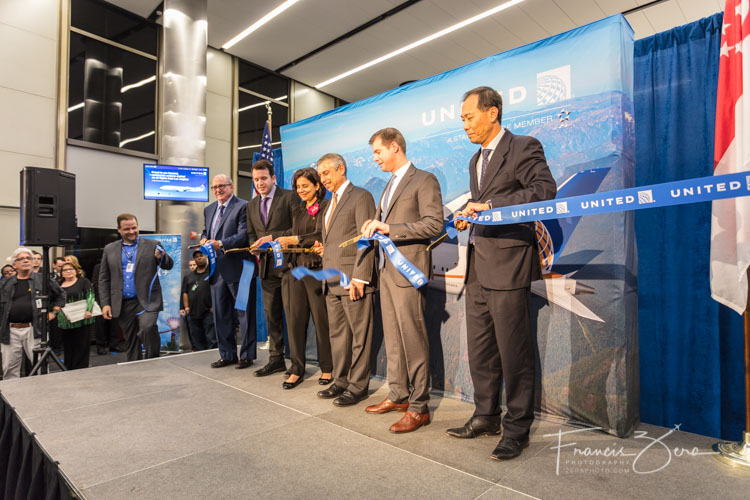
There was even a ribbon-cutting ceremony – the presence of a trade delegation highlighted the fact that economic ties are strong between Singapore and the U.S.
The flight takes 17 hours, five minutes to cover the 8,772 miles between Los Angeles and Singapore. Favorable headwinds shaved an hour off our flight time, but, still. It’s an awfully long time to be in the air.
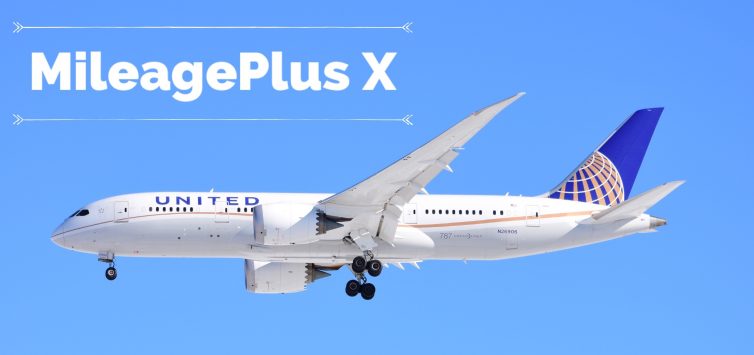
MileagePlus X: A simple way to earn free #UA787 flights – Photo: JL Johnson
Let’s get something out of the way. I am not a United fan. In fact, I have said numerous times that all things equal, I’d rather fly Spirit. Why do I bring this up? Because after using United’s MileagePlus X App for a year, I’m starting to come around. And that, my friends, is a pretty big deal. Opinions formed from years of disappointment and failures at all levels don’t change overnight. They certainly don’t change as the result of side-project ancillary revenue apps. But here I am, about to tell you why you should be a MileagePlus X user too.
The United MileagePlus X concept is simple: Use the app to buy gift cards for everyday purchases at thousands of retailers and get United miles as a kickback. Earnings per dollar spent at merchants vary widely, typically between one and five miles. Earnings are dependent upon on the merchant and the time of year. For example, the standard for Amazon seems to be one mile per dollar, but I have seen up to three. The norm for Gap/Old Navy/Banana Republic is five, but for a while during back-to-school season earnings jumped to ten miles per dollar.
This arrangement is win/win/win. United gets a slice of the transaction (yay ancillary revenue!), the retailer gets a sale they may have otherwise lost, and the consumer gets miles. The concept United is using is far from the typical dining or shopping programs offered by nearly every other airline. When I think of the words “innovative” and “pioneer” United does not come to mind. But both apply in the context of MileagePlus X.
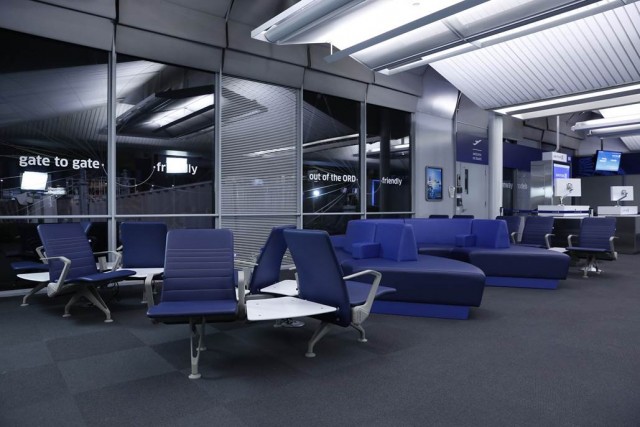
Updating the gate area means seating that can be enjoyed by everyone – Photo: United
On my recent trip to Chicago with United to experience their new United Club cuisine, we were shown something that the airline had been working on. Something that would have been obvious to so many, but that not so much to others. United has been working on many different ways to improve their boarding experience.
We have all had a bad boarding experience. A delayed flight, people massing at the gates (gate lice), no order at all, bad communication, and confusion. Airlines all board aircraft in different fashions, and each airline has someone (or a team) of people, who are consistently re-evaluating how the boarding process can efficient. Some new methods work well, others are silently stopped and never spoken about again.
But what is sometimes forgotten about in the boarding process is what that gate area looks like, how it is handled, and how passengers actually feel about it. United has decided to take a look at all of these factors and decided on trying a new boarding experience — one where even passengers had some role in the decision-making process.
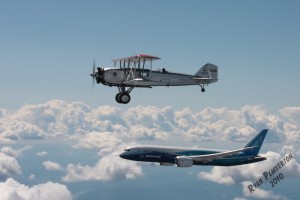
Boeing's oldest (Model 40) and newest planes (787 Dreamliner) flying together. Photo by Ryan Pemberton.
Here is the long awaited part 3 of my inside look at the Boeing Archive. I apologize it has taken so long to get this published.
In part 1 I took a look at what is inside the Boeing Archive. Then part 2, I took a closer look at some of the models in the Boeing archive. Now, I will post my interview with Boeing Historian Michael Lombardi. What is amazing is Lombardi did our whole interview from memory. I broke our interview it into two parts, with the second one posting tomorrow. Enjoy is our exclusive interview:
AirlineReporte (AR): How long have you been the Boeing Historian?
Michael Lombardi (ML): I’ve been doing the History thing for 16 years.
AR: You have to realize that you have one of the coolest jobs in the world, right?
ML: Well, I was sitting with Mike Carriker, Chief Flight for the 787 and I always joke that, well I have second best job in the world.
AR: How the heck did you get this job?
ML: I was really blessed to get this job and more of a case of being at the right place at the right time. The archives used to be with our technical libraries and I worked with them and the manager knew how much, like yourself, how much of a passion I had for aviation and having studied history and such and she said, ’œyou’d be great for this job. You need to go on and apply for it’. And I wasn’t even aware that the historian was retiring, so of course, I always thank this now retired manager profusely for doing this because I thought that was very forward looking and being a good manager and saying ’œhey, I think this employee would be a good fit for the position’.
AR: Do you have a staff?
ML: Yes, I have a very small staff. It’s me and Tom, and that is who’s here and we have a historian archivist in southern California and one in St. Louis. So there are four of us. Tom and I work for Boeing Communications and our two other historians work for the defense side of the company.
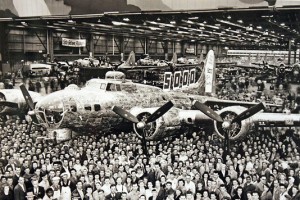
Employees gather with the 5000th Boeing B-17 made at Plant 2 in Seattle during WWll. Photo by Boeing.
AR: Knowing Boeing’s past pretty well, where do you see Boeing’s future?
ML: I think one thing you see is that the company will continue to lead the way as far as what’s the next step. And throughout history it seems that Boeing has introduced the products and technology or the innovations that have pretty much defined where flying is going to be, where travel is going, how airplanes are going to be used, or space vehicles. The company has been a leader throughout history and I don’t think that’s going to change.
AR: What is something that amazes you about Boeing?
ML: One of the things that always amazes me are the people that work here are so smart’¦ sometimes it just makes you say ’œwow’. And it makes you think, ’œHow can we not do the coolest things in the world?’ And then given with leadership that just says, ’œDo what you need to do and we’ll support you and give you the tools that you need and the support’¦’ and when you have that kind of leadership, the future is just completely open. I think it’s really cool.
AR: How do you think that William Boeing, the founder of Boeing, would view the company today?
ML: I think he would be very pleased with the company. His thing was that he wanted the company to constantly looking at new ideas and doing research, and doing development and always being at the forefront of aviation; bringing together all of the ideas and all of the newest ideas, and being a pioneer. That was a big thing for him. And I think that spirit it still here and that is what keeps the company going, it’s that pioneering spirit.
AR: Boeing used to run their own airline and many people ask, ’œWhy doesn’t Boeing have an airline today?’
ML: That’s a great question. A lot of it has to do with the laws about people who make airplanes shouldn’t be flying them too. So, that was pretty much it. In 1934 the government passed laws where the airplane manufactures couldn’t own airlines. So this kind of broke up what Bill Boeing had started.
It’s pretty amazing what he had done. They had the small airplane company here in the northwest in Seattle. And he was pretty successful but it was a small company, so what was the next big step? How do you expand this business and this is one thing to remember about Bill Boeing, is that he was a businessman. He wasn’t like a lot of pioneers out there that started the aerospace industry, a lot of them where engineers and some designers and they built an airplane and started a company. Bill Boeing looked at the airplane as a business.
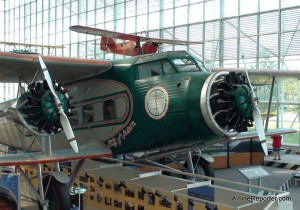
Boeing 80A-1 with "Boeing Air Transport" located at the Museum of Flight.
He was pretty visionary. You look at the articles of incorporation and he said that airplanes are going to be used for commerce, and for business travel, and passengers, and I want to have schools to train pilots and all of this. And at that time people looked at airplanes as a curiosity and there was no idea that you should fly an airplane on a trip and no one had conceived of that at that time.
You get up to 1927 and Bill Boeing decides to expand his business and goes into the airmail route, from Oakland, CA to Chicago, the biggest one in the country at the time. To do that, he had to give a low bid, and created the Model 40, which used an air cooled radial engine. Where other airplanes were water cooled and very heavy because they are carrying the water for the engine, the Model 40 was lighter and carried more mail, so Boeing won the contract. And this is the start of Boeing Air Transport. With that airline, he’s a businessman and he goes out and buys other airlines to make his airline bigger and then he’s like ’œwe need engines for airplanes’ so then he goes to Frederick Rentschler and says ’œI want Pratt & Whitney to become part of my company’ and they merge together. Everything under one roof. Great idea, right? And because of that Boeing goes out and builds airports and starts all these routes. There’s a couple other airline pioneer companies out there as well, but some of the things that Boeing did was design safety features and radios communication and ways to guide airplanes. Bill Boeing started this aviation infrastructure throughout the country and a lot of people forget that – that there really is a debt owed to Bill Boeing for doing that.
AR: Was there ever resistance to this new air-industry?
In 1934 you had a change in government, and of course the depression, and during the depression you have the airline industry just cooking along like nothing’s wrong and they’re making money and they are very successful’¦ so, they must be doing something illegal. Think about our recent history, which isn’t a whole lot different than back in the 1930’s, the car industry, the executives being called up in front of congress and those congressmen going ’œgrrr’ and the grandstanding in front of them. The same thing happened in 1934 but at that time you had Bill Boeing being rushed up there and being scolded.
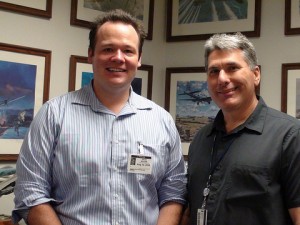
Mike Lombardi and me inside the Boeing Archives.
But at that time he had Charles Lindbergh, who is this public hero. You know the greatest guy in the world. American’s love him, and he gets up there and tells congress, ’œYou guys are all wrong. These guys have given you this wonderful gift of an airline infrastructure’, they have connected America with airplanes and you can go anywhere to do commerce and business, and this is something you need to thank them for. So that kind of stopped that whole bit. The result was they passed laws that said, they were going to break up these big holding companies. United Aircraft & Transport was broken up and because his big empire was being broken up, he just said ’œYou know, I’m tired of this. You hauled me in front of congress and you are calling me a liar’¦’ and he was a gentleman and a man of his word, very ethical. To call him this name was a very big offense to him and his character. And he said ’œI’m done with it’. And he’s already a rich man when he starts the company, this was business interest, it wasn’t his livelihood.
AR: It seemed really interesting to me that he got out pretty quick. He could have stuck around.
ML: He’s only around for about 18 years. He leaves the company and the company is broken up. You get the Boeing Company with the Wichita Stearmen division is made up into one part of the company. Everything on the east coast with Pratt Whitney, Sikorsky, and Hamilton Standard and all these other small companies like Chance Vought are all clumped together in this company called United Technologies. This is still around today. And then all of the airline interests are all previously called United Transport Corporation, are now called United Air Lines, which is now United Airlines. So these three big aerospace concerns that are still around and most of them are still very successful are companies started by Boeing. This is pretty amazing.
AR: It is amazing to think about how many companies have come and gone since then.
ML: The guy was really like the Bill Gates of his day. He was this amazing businessman.
Tomorrow I will post our interview where Lombardi talks about what he feels the best and worst decisions Boeing has made, as well as other interesting facts.
Inside The Boeing Company Archives
PART 1 | PART 2 | PART 3a | PART 3b | ALL PHOTOS | ALL STORIES








